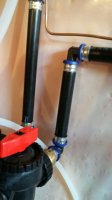Hello All,
I recently replaced a 22 year old Culligan unit with a new unit featuring a Clack valve from a local water conditioning company. Please take a look at the pictures of the install, I'm wondering if he used the proper elbows for the diameter of piping, they seem to be smaller. Could this cause a restriction when multiple appliances are using water simultaneously?
Thanks

I recently replaced a 22 year old Culligan unit with a new unit featuring a Clack valve from a local water conditioning company. Please take a look at the pictures of the install, I'm wondering if he used the proper elbows for the diameter of piping, they seem to be smaller. Could this cause a restriction when multiple appliances are using water simultaneously?
Thanks


